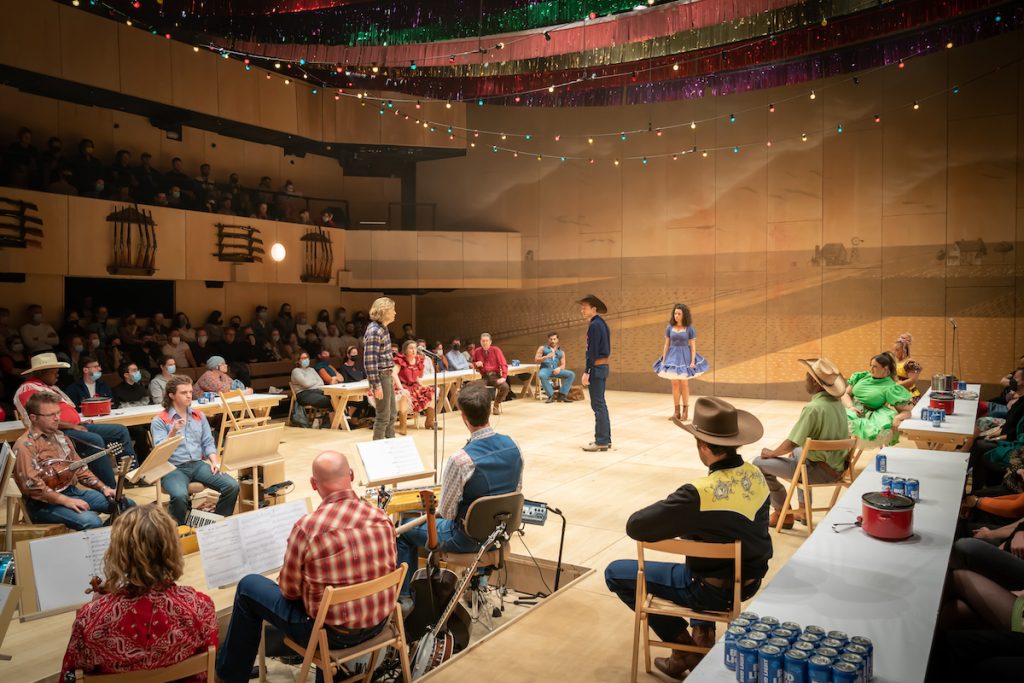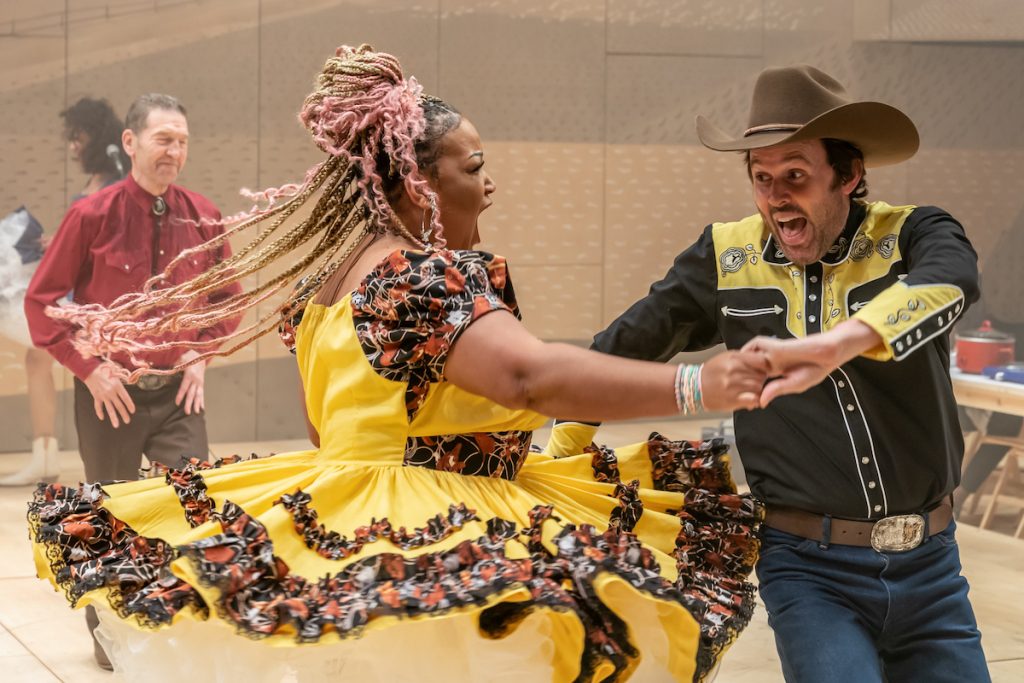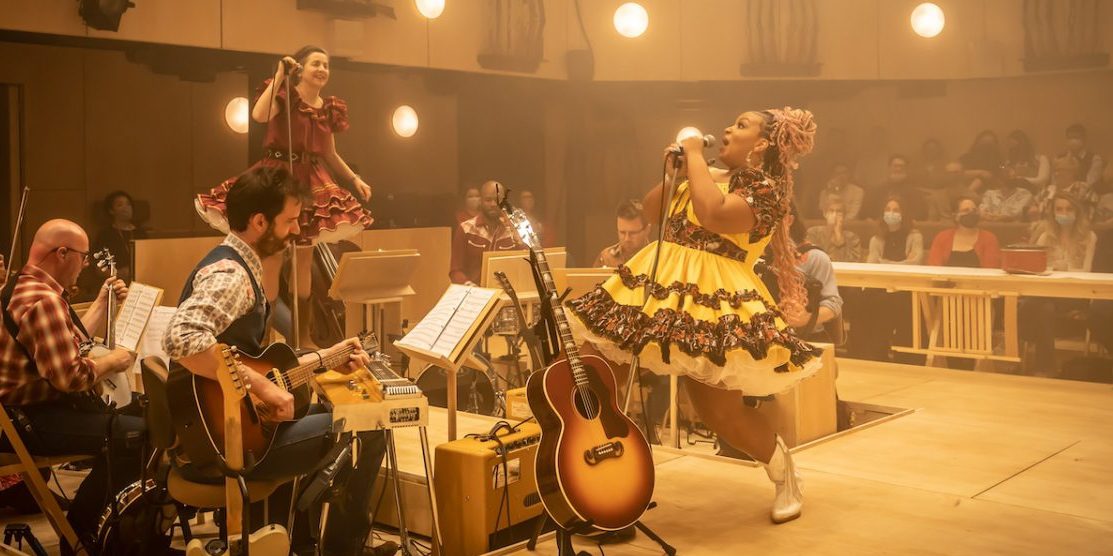This classic musical has received so many outings the first question to pose is why make another? This production, originating at Bard College and then migrating via Broadway and a number of Tonys, now comes to the Young Vic with a dark but compelling set of answers. Far from being a simplistic, thigh-slapping, all-American evocation of cowboys and farmers in the early days of the Southwestern frontier, we find a dark, brooding meditation on the marginal outcomes of rural poverty, with the boundary between success and failure uncertain until the final scene.
Cowboy Curly fancies his chances with ranch-owning Aunt Eller’s niece Laurey; but she prefers to go to the local dance with hired hand Jud, whom everyone else regards as a bad lot. A second young couple, Will and Ando Annie also fail to get together for much of the action through a series of misunderstandings and the intervention of a Persian pedlar, Ali Hakim. An outer ring of character actors completes the local scene, giving a cast of twelve in all, accompanied by an orchestra of seven. All the conflicts of the first half are dissolved or resolved at the community ‘box social’, in the second.
What is most astonishing here is the reworking of the music. Yes, the familiar tunes are all still there but clad in harmonies and instrumentation Richard Rodgers would never have imagined that then force you to imagine and experience them afresh. With the use of banjo and a variety of electric and acoustic guitars, strings, and percussion, there is exuberance and brio, to be sure, but also a sinister and anxious undertow that helps to reinforce the detailed ambiguity of the central characterisations.
The Young Vic is reconfigured as a community hall in pale wood with the stage set in traverse, which helps to involve the audience in the action. Guns are fixed in decorative patterns on the walls and walkways around the orchestra pit provide ample room beyond the main stage for song and dance routines. Costumes mix period detail with contemporary clothing and lighting effects alternate between full house lights for the main scenes, through a soft green for fantasy sequences, to complete blackouts for the sinister confrontations – the latter having a genuinely creepy effect that really gets under your skin.

In the lead role of Curly, Arthur Darvill, projects a wide range of emotions – swagger, confidence, and charm, to be sure, but also an apparently callous indifference and determination to succeed at all costs, which makes his role much more intriguing than usual. The same can be said of Anoushka Lucas, who finds gritty independence in Laurey which makes her determination to dream her own dreams all the more credible. Both of them have high-level musical skills, with Darvill playing his own guitar solos, and Lucas offering an imperious purity of voice in the manner of Audra Macdonald, despite forcing the tone a bit on occasions.
There are no weak links elsewhere in the cast. As the secondary couple, Will and Ado Annie, James Davis, and Marisha Wallace have real chemistry and personal charisma, as well as developed acting and dancing skills that stay just the right side of exaggeration. Wallace in particular has a fabulously flexible voice that makes all her contributions stand out for excellence.

Stavros Demetraki finds the right combination of cheeky humour and cunning exasperation as the exotic figure of the Persian travelling salesman; and Liza Sadovy anchors the production as Aunt Eller, the critical voice of older common sense, who is the real savvy leader of the community, despite the fact that on the surface this is a man’s world. There is also a detailed cameo from Greg Hicks as a controlling father figure, and a special mention should go to Patrick Vaill’s forensic portrayal of the outsider, Jud. He comes over here not as a two-dimensional villain, but as a damaged victim, which in turn makes his presence and actions all the more unsettling in practice.
A major departure in this production is to shift the fantasy ballet sequence from the end of act one to the start of the second half. Marie-Astrid Mence delivers a fine embodiment in movement of not just Laurey’s dreams and aspirations, but the hopes and fears of the whole community. The musical backcloth for this is a mesmerising sequence of shivers, riffs, and variations around the key melodies of the musical, a high point of the work of musical supervisor Daniel Kluger, and choreographer, John Heginbotham.
This is not Oklahoma as we have known it, but all the better for that distance and difference.

